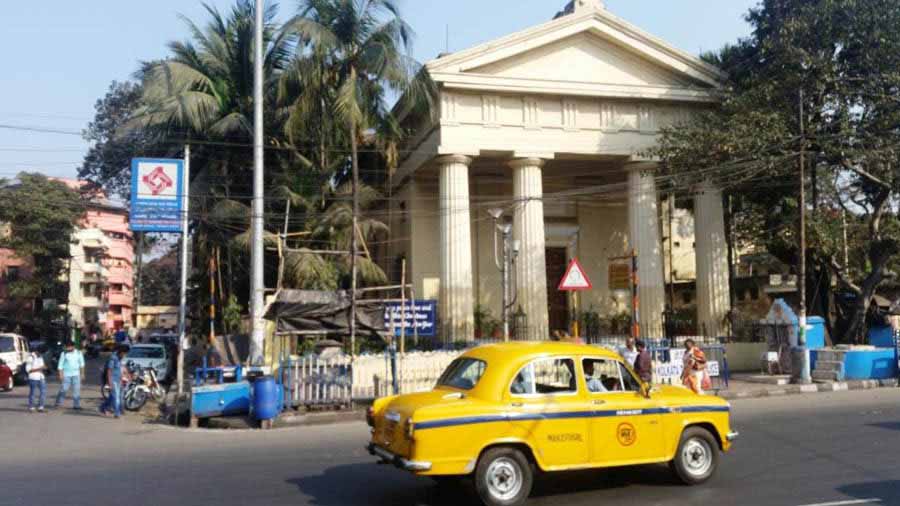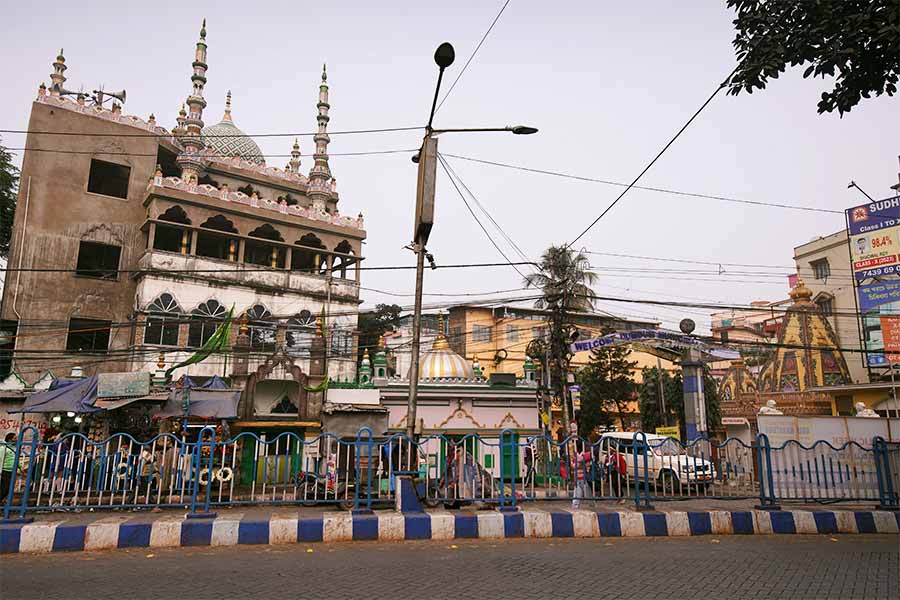Kalighat Temple pilgrims from north Kolkata undertake a ritual. After they alight on SP Mukherjee Road, they first turn left instead of right. They do a roadside pronam in the direction of a closed Greek Orthodox Church before turning around, crossing the road, and proceeding on their journey. In their chronological sequence, it is Christ first, Kali next.
The Greek Orthodox Church is one of its kind… the only Greek church in India, the only Calcutta church where the occasional service is still in Greek, a spireless church that could architecturally have been sliced out of Athens and possibly the youngest among heritage churches in the city (completing its centenary this year).
The word ‘Greek’ is a lock opener. Provokes interest. Arouses curiosity. Enhances rarity value. And quite relevantly. Considering that what used to be a community of 500 at one time — buying raw jute, trading commodities, exporting products — is down to its lowest common denominator. Just. One. Person. Sister Nectaria Paridisi.
She is sitting in front of me in the visitor’s lounge at the Greek Orthodox Church. Head to heel in a black chador (looking every bit Iranian in my mind but for her visage). Speaks English slowly. Uses precise words (she used ‘conscientious’ and I felt comfortable). Springs the odd vernacular. Laughs till it wrinkles.
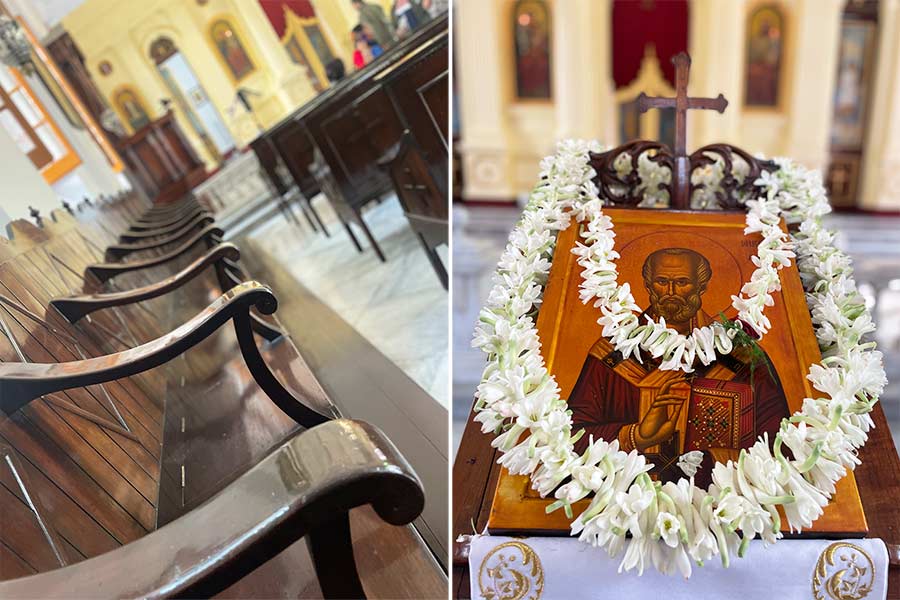
It was perhaps to rebuild a community that Father Ignatios and Sister Nectaria Paridisi were sent to the Kolkata church
I ask the usual boring what-why-where-whens. Turns out that Sister was assigned to Seoul when the Bishop of New Zealand messaged: ‘Report to Calcutta.’ She may have wondered. The Greek Orthodox Church in Calcutta had been closed for nearly two decades; the last service had been concluded in 1972; the last Greek had long left.
These could have been the very reasons why two Greeks – Sister came with Father Ignatios – were dispatched on a mission. Rekindle a relationship. Restore the church. Recreate a community.
When Sister and Father entered, they – to evoke an analogy not quite different from what the explorer had whispered after he had prised Tutankhamun’s tomb open to those behind him: ‘Everywhere the glint of gold’ – saw only black. There hung a concentrated staleness of decades of having been boxed in. Sister Nectaria’s hands cup her cheeks when I ask her what she first saw. She stretches the adjective: ‘Dirtyyyyyyyyyy.’ Only the church pendulum stirred.
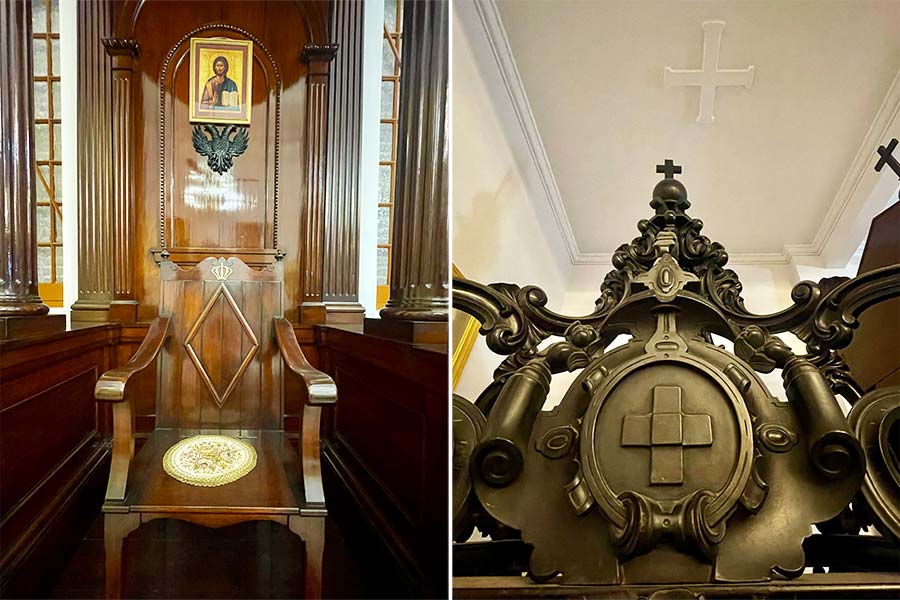
The entire 4,000sq ft of the church had to be scrubbed and polished before the Sister and Father could reopen the church
The evangelists got down on their knees but this time for a different service. They swept. They rubbed. They scraped. The first dust crust came off. Revealing another. They began to recognise the gravity. To achieve any outcome, they would need to go vertically downwards, then horizontally lateral before they even arrived at the marbled floor. And 4,000sq ft needed to be scraped inch by inch before they turned to the real enemy.
Termites. ‘Everywhere’. That is how Sister describes them. The Lord’s ornaments were a relic. The Bible flaked on touch. The clothes had to be discarded. The wood feast had lasted nearly two decades. Sister and Father turned to a specialist each weekend for 18 months. They may have visualised the prospect of starting services within days of arriving in Kalighat. One of the first tests was that of forbearance. They were required to venture into the Kalighat hinterland to buy the diesel to get the kitchen fire going; they were required to fuse two foreign languages and the good old semaphore to communicate. And then they did something unusual; they went shop to shop distributing cakes, wiring homes and sinking tubewells. It wasn’t just the church they would be turning around.

The woodwork was carefully restored after a termite infestation and it took about three months before the first service was held
Three months later, Father Ignatios pushed the church door on SP Mukherjee Road open. To welcome the first devotee in nearly two decades. Within minutes, only standing room remained.
The irony was that every word the priest spoke was Greek to the audience – in more senses than one. But Sister Nectaria says that in that moment when it would all have appeared so meaningless, the unexpected transpired. An audience that should have said, ‘Kichhu bujhte parchchi na’, closed its eyes, bent its heads, and soaked the intonation. Some bent forward. Some clasped their hands. Some had moist eyes. Before a syllable had been understood.
The word permeated. A place of worship had been revived. Bideshis were filling their ‘cathedral’ with sounds that could be interpreted as widely as the listener’s imagination. This was more than a religious ritual; it was evolving into a spiritual experience. Someone went back and said ‘Bujhte parlam na kintu bhalo laglo.’ Another said, ‘Ora amader khoob-i welcome korlo.’ A third said, ‘Jani na, kintu okhane kichhu achche.’ Until one day Father Ignatios looked up from the pulpit, froze… but did not show it. Sitting in his church were Hindu monks. They sat wordlessly, contemplated in silence, did a namaste when the service ended and left as soundlessly as they had come. It takes years, even decades, for a place of worship to graduate from ‘Christian’ or ‘Muslim’ or ‘Hindu’. In just a few weeks, the church was being referred to as ‘Bhogobaner jaayga.’

Even with the language barrier, the faithful filled the pews and the Greek Orthodox Church became Kalighat's new ‘Bhogobaner jaayga’
I went to the Greek Orthodox Church – much observed externally but never entered, which is the story for most of us – a month ago. The Doric columns resembled Athens’ Parthenon. The facade had been illuminated warm yellow. The chandeliers looked curvaceously exquisite. The furniture appeared newly brown-polished. The oil canvases of the Greek saints indicated the Renaissance style over the Byzantine. The names on the oil canvases of Greek saints were bilingual. The icon of St Catherine was quite like the one in Sinai (possibly influenced by a priest who had come from Sinai). Over the top of the door of the Iconostasis leading to the altar were the first and last letters of the Greek alphabet – alpha and omega – indicating that for the holy spirit there is no beginning, no end. At the base was a symbol that resembled an ‘X’ embedded with a ‘P’ that symbolised Christ. There was no church bell within; there were no cushions for kneelers.
I did some walking around. There was no spire, explained by the Biblical conviction that ‘Christ unites all things in himself, things in heaven and things on earth.’ The church rectangular resembled an ark that saves the world from the deluge of temptations. A plaque in Greek said: ‘It is in the memory of the Greeks who donated generously to build the first church in Amratollah…Their bodies are buried but their names will remain alive for generations.’
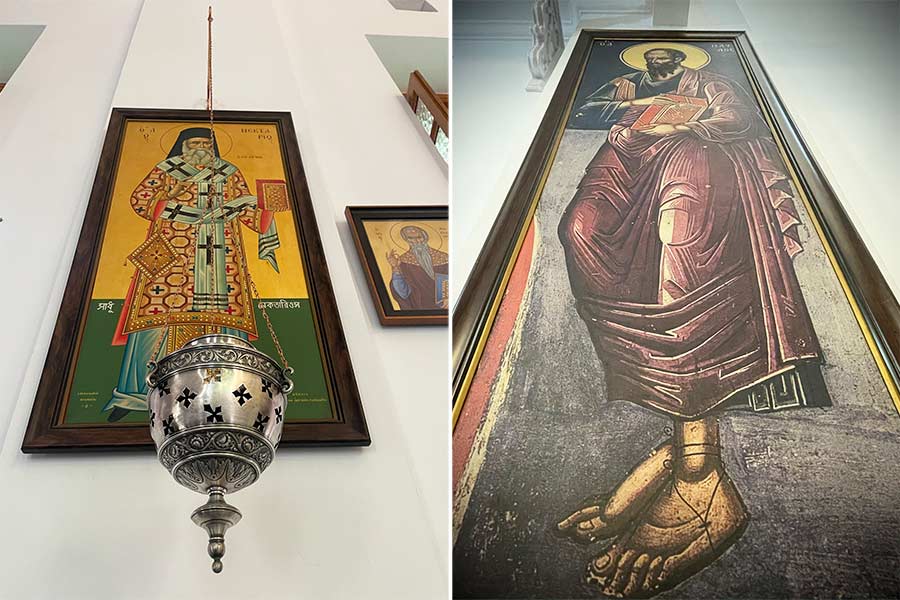
The oil canvases of the Greek saints indicate the Renaissance style over the Byzantine, and have names written in two languages
The Greeks of the day took this sentiment seriously for a reason. Their first church was inspired by an act of weather. The first Greek settler of some means in Calcutta was Hadjee Alexias Argyree from Philippopolis, who arrived in 1750. Twenty years later, on a sea voyage between Calcutta and Mocha/Jeddah, his vessel was close to sinking when Argyree messaged a divine SOS: ‘Lord, if you save this ship, I will build for you a church in Calcutta.’
It worked. The sea calmed. Argyree returned. He transacted for land. Three years after he passed away, the church became a reality in 1781 (which would have made it older than the celebrated St John’s and would have been the oldest in the city had it been standing). Dedicated to the Transfiguration of the Redeemer on Mount Tabor. In addition to the principal corpus of Rs 30,000 from the Argyrees, there were contributions from the Parthenios, Georgios, Chritodoulus, Mavroidis Leontiou, Mitsou and Andriadis families. Topping that was a Rs 2,000 donation from Warren Hastings himself. One hundred and forty years later, the Amratollah property was sold, the church relocated and its furniture transferred to the second where it still stands, all 1780 vintage, except for what was destroyed following the termite invasion of 1972.

Among those who contributed in the making of the church was Warren Hastings himself, who donated Rs 2,000
I would have thought that this was the most remarkable Greek remnant in Calcutta. Sister Nectaria smiles; I am mistaken. The ‘miracle’ (her word) lies in semi-urban Thakurpukur, where she oversees an orphanage. More than 600 have graduated across the last three decades; the existing group comprises 112; ten students have gone on to become teachers at the institution.
Come, she says, when I rise to leave, ‘you will love the school we have created’. She extends her hands. It is an invitation. I shake hers. Possibly the softest hands in a long time.
And that is the memory of the Greek Orthodox Church and its residents that I will carry. Soft hands.
Reality of an individual; metaphor for a church; reflection of a community.



